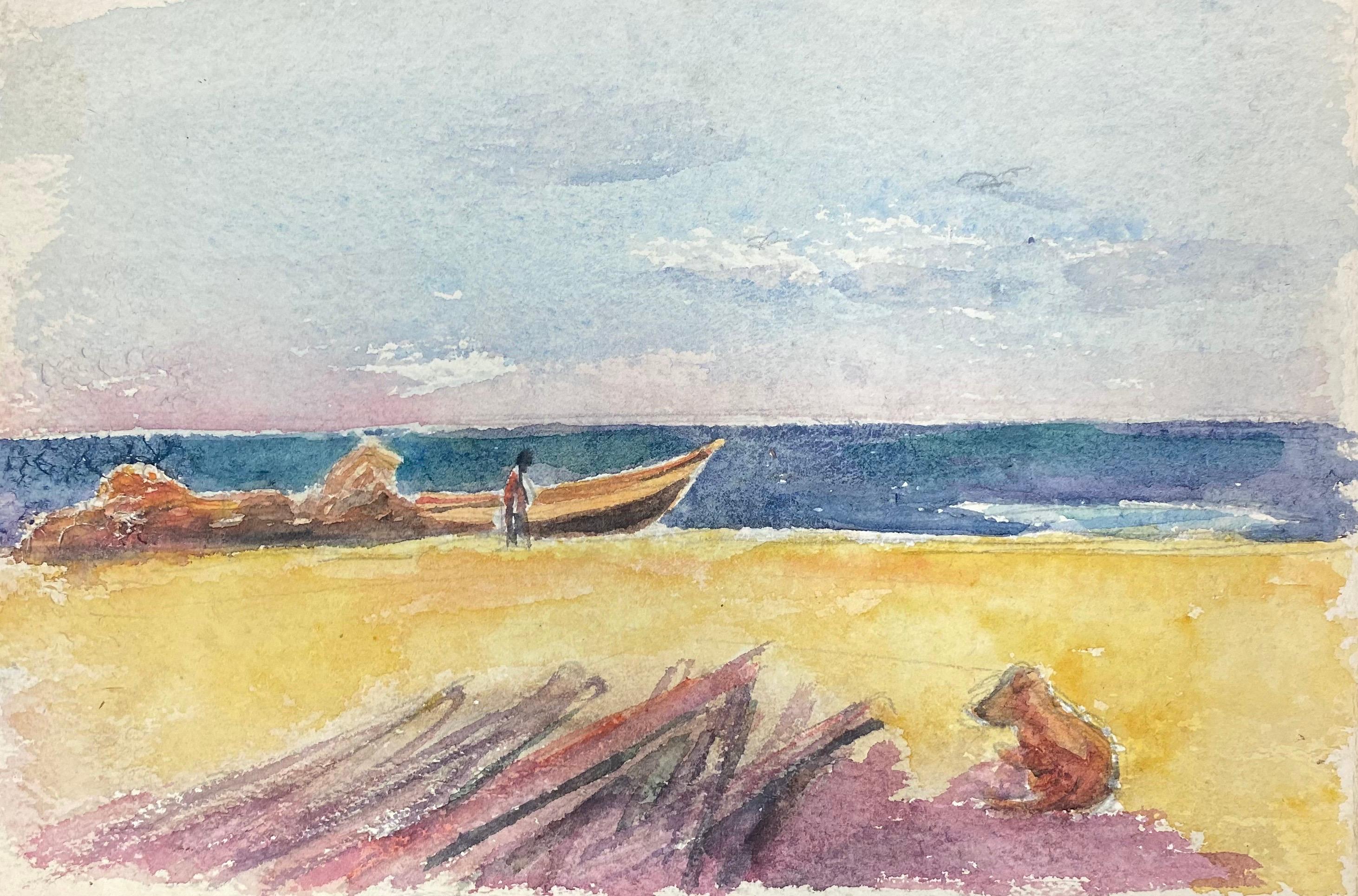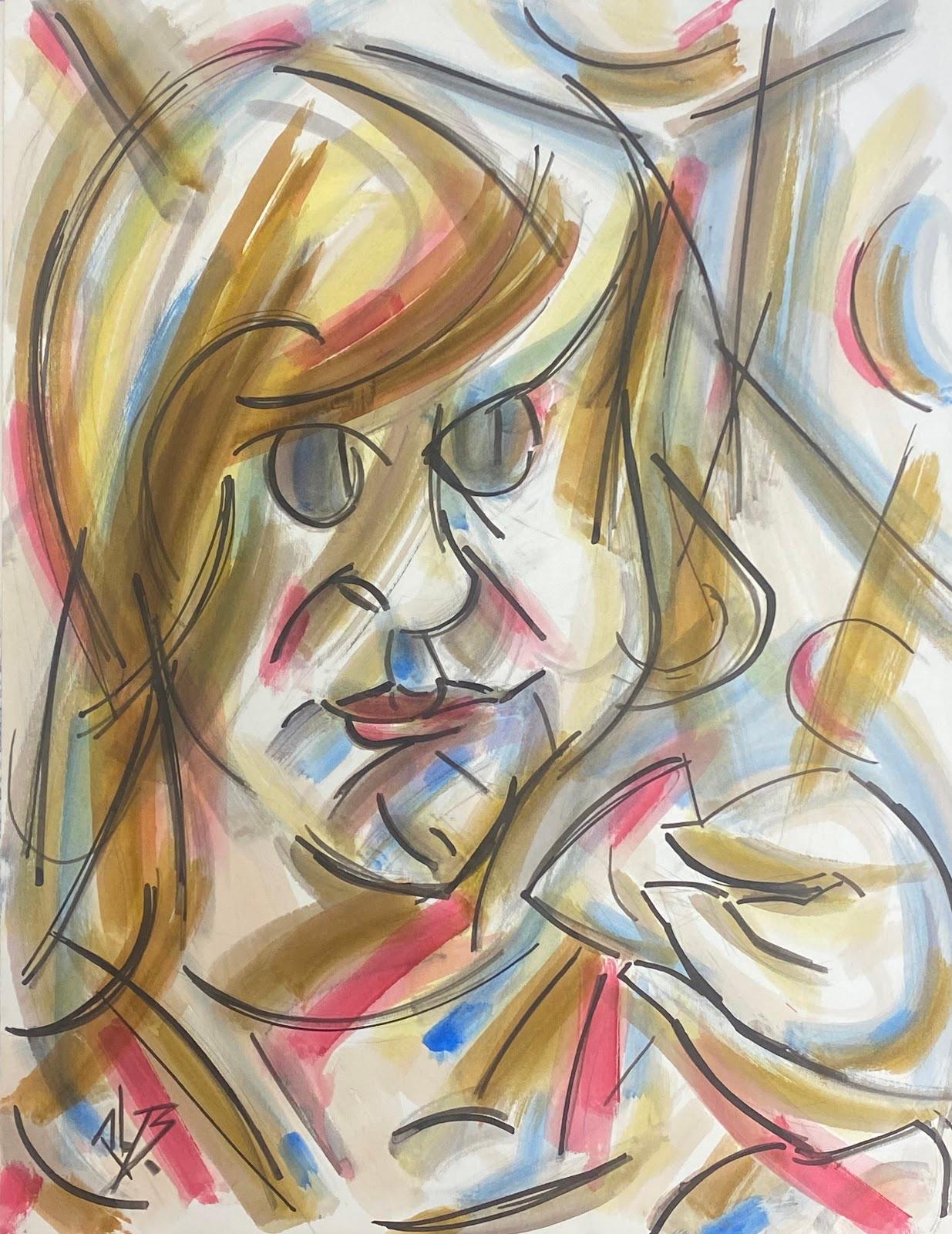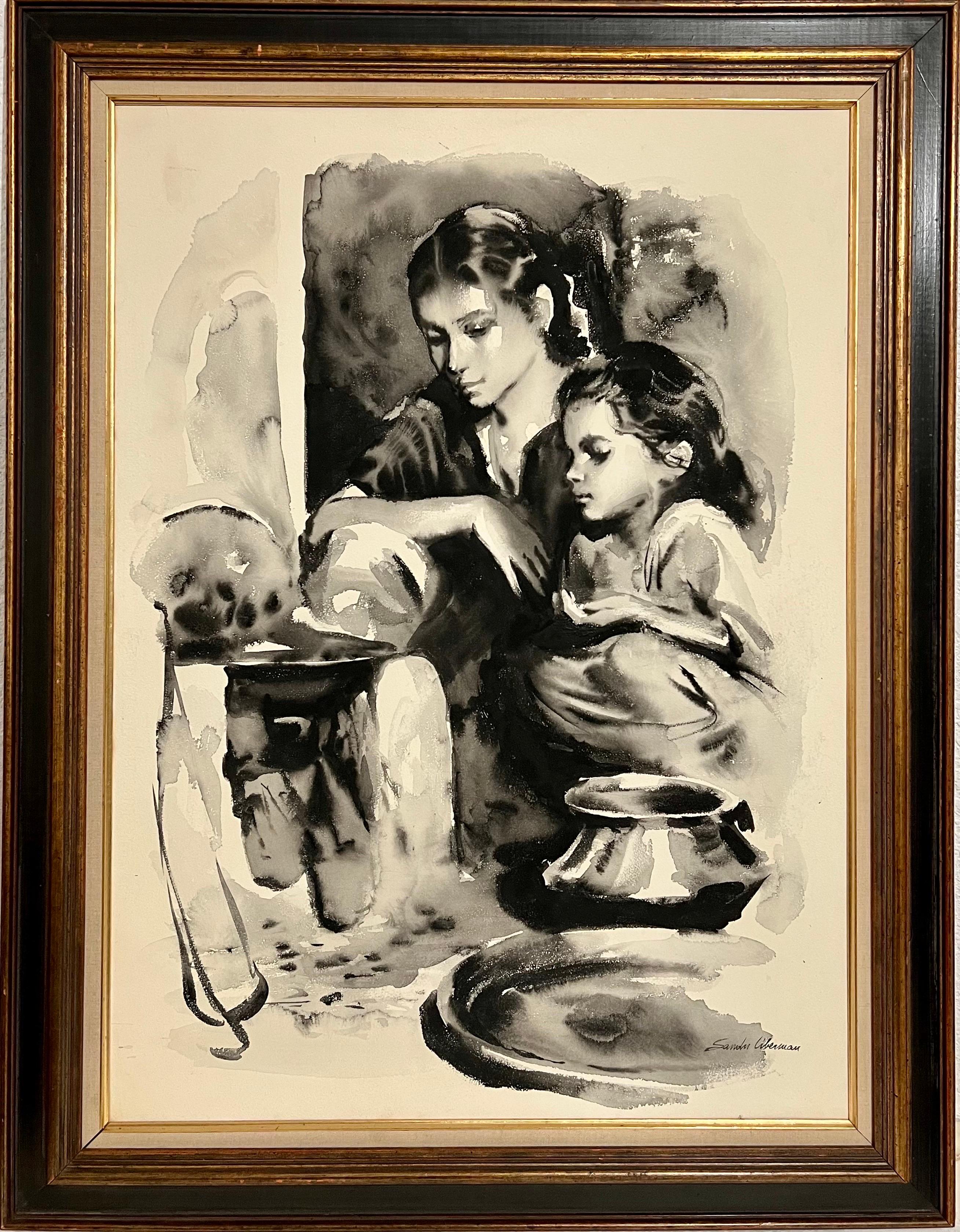Items Similar to Workers Loading Freight Train
Want more images or videos?
Request additional images or videos from the seller
1 of 6
Arthur Burdett FrostWorkers Loading Freight Train1900
1900
About the Item
Image of workers loading barrels in a train yard.
Signed Lower Left.
Arthur Burdett Frost was our best illustrator of rural America. He usually treated his characters with humor, and in his drawings there was a directness and honesty which showed his sympathetic understanding of his subjects. His sound draughtsmanship was combined with an intimate knowledge of nature. The details in his pictures are always very specific, as though drawn on the spot, and so artfully chosen and placed as to carry out the picture’s idea in a natural and entirely convincing manner.
He may be best remembered now, however, for his charming illustrations for the Uncle Remus tales by Joel Chandler Harris. In the preface and dedication by Harris for the 1896 edition, he wrote of Frost “…you have conveyed into their quaint antics the illumination of your own inimitable humor, which as true to our sun and soil as it is to the spirit and essence of the matter… The book was mine, but now you have made it yours, both sap and pith…”
Frost was appreciated as a wood engraver and gravitated to work as a lithographer. His first success came with his illustrations for Out of the Hurly-Burly by Max Adler. He became a member of the Harper’s Brothers art staff alongside Abbey and Pyle, studied with Thomas Eakins and William Merritt Chase. The Frost family also sojourned in France for a long period of study for Frost and his two sons.
- Creator:Arthur Burdett Frost (1851 - 1928, American)
- Creation Year:1900
- Dimensions:Height: 20 in (50.8 cm)Width: 15.5 in (39.37 cm)
- Medium:
- Period:
- Condition:
- Gallery Location:Fort Washington, PA
- Reference Number:1stDibs: LU38431014473
Arthur Burdett Frost
A famous illustrator and sporting artist, Arthur B. Frost is perhaps best known for his illustrations for the Uncle Remus tales by Joel Chandler Harris, as well as for naturalistic hunting and shooting prints. Many consider him to be the best illustrator of rural America. An ardent sportsman himself, many of Frosts favorite subjects were hunting, fishing, and golfing. Often his golfing subjects tended towards humor. His scenes capture the drama of the sport - a hunter poised to shoot and a dog on point - with elements often integrated into a richly detailed woodland or marsh setting. Frost chronicled aspects of America's cultural life for over five decades. From the late 19th to the early 20th centuries, his art appeared in the many books and publications of the time, including Harper's Weekly, Scribner's, and Life magazines. Frost's illustrations always evoked the essence of a setting and its mood, whether depicting the hilarious escapades of the family cat or farm dog, or the serene pastoral lifestyle of the native northeast. His sound draftsmanship was combined with an intimate knowledge of nature. Frosts details in his pictures were very specific, as though drawn on the spot, and done in a very convincing manner. In the preface and dedication by Harris of his book Uncle Remus, Harris wrote of Frost "you have conveyed into their quaint antics the illumination of your own inimitable humor, which is as true to our sun and soil as it is to the spirit and essence of the matter. The book was mine, but now you have made it yours, both sap and pith" Other well known examples of Frosts illustrations are Brer Fox and Brer Rabbit from The Tar Baby. Frost was known to have spent time in the art colony of Rockport, on the Eastern Shore of Cape Ann, Massachusetts, where he is said to have gone because of painter Gilbert Tucker Margeson. He also summered at the noted Shinnecock Hills Summer School of Art, which William Merritt Chase set up a few miles west of Southampton, New York. Shinnecock Hills became the best known of all the out-of-doors summer art schools that developed in America during the late nineteenth century, and attracted hundreds of aspiring young men and women, including Frost, Rockwell Kent, Lydia Field Emmet, and many others. Frost was red-green color blind, but it was not a great handicap since the majority of his work was reproduced in black and white. He managed to work successfully in color by reading the labels on the tubes and placing the colors in the proper order on his palette. Arthur Frost is the father of impressionist painter John Frost (b. 1890 in Philadelphia - 1937), and as a young man John studied art with his father before going on to study in Europe.
About the Seller
5.0
Recognized Seller
These prestigious sellers are industry leaders and represent the highest echelon for item quality and design.
Gold Seller
These expertly vetted sellers are highly rated and consistently exceed customer expectations.
Established in 1995
1stDibs seller since 2016
107 sales on 1stDibs
Typical response time: 5 hours
- ShippingRetrieving quote...Ships From: Fort Washington, PA
- Return PolicyA return for this item may be initiated within 14 days of delivery.
More From This SellerView All
- New York Yankees Watching the Football GameBy Constantin AlajalovLocated in Fort Washington, PASigned Lower Right by ArtistCategory
Mid-20th Century Paintings
MaterialsGouache
- Twas The Night Before ChristmasBy Jessie Willcox SmithLocated in Fort Washington, PAMedium: Gouache and Watercolor on Board Sight Size 18.00" x 17.00", Framed 25.00" x 24.00" "Twas The Night Before Christmas" by Clemen...Category
1910s Figurative Paintings
MaterialsGouache, Watercolor, Board
- No Passing, Saturday Evening Post CoverBy Stevan DohanosLocated in Fort Washington, PAApproximate Date: 1954 Medium: Gouache on Paperboard Signature: Signed Lower Left Size: 26 1/8 x 20 in. Saturday Evening Post, October 9, 1954, cover illustration. Exhibited: Norman Rockwell Museum...Category
1950s Landscape Paintings
MaterialsPaper, Gouache, Board
- Bag and Baggage, LIFE Magazine coverBy Clarence Coles PhillipsLocated in Fort Washington, PALIFE Magazine cover, December 15, 1921 "Coles Phillips embodies innovative American periodical and advertising design between 1911 and 1927, a period considered a Golden Age of illu...Category
1920s Paintings
MaterialsGouache
- Girl on Swing, Good Housekeeping Magazine CoverBy Jessie Willcox SmithLocated in Fort Washington, PAMedium: Gouache on Board Signature: Signed Lower Right Sight Size 20.00" x 15.00", Framed 30.00" x 24.50" Jessie Wilcox Smith never married, but t...Category
1920s Other Art Style Paintings
MaterialsGouache, Board
- The Coiffure, Collier's Magazine CoverBy Frank Xavier LeyendeckerLocated in Fort Washington, PAApproximate Date: Apr 23, 1903 Medium: Gouache on Board Signature: Signed Lower Right Dimensions: 22.50" x 15.50"Category
Early 1900s Figurative Paintings
MaterialsGouache, Board
You May Also Like
- Figure on Sandy Beach Boat & Dog, French Expressionist Original PaintingBy Akos BiroLocated in Cirencester, GloucestershireAKOS BIRO (HUNGARIAN 1911-2002) watercolour/ gouache painting size: 7.5 x 11 inches Beautifully colourful, original painting by the very popular and highly regarded Hungarian/ Frenc...Category
Late 20th Century Expressionist Landscape Paintings
MaterialsGouache, Oil Pastel
- French Modernist Gouache Painting Multi-Color Portrait Of A Young GirlLocated in Cirencester, Gloucestershireby Paul-Louis Bolot (French 1918-2003) signed original gouache painting on thick paper/ card unframed condition: very good and sound; the edges have a few curls and scuffs/ edge tear...Category
20th Century Modern Figurative Paintings
MaterialsGouache
- Large Gouache Original Painting Mother & Daughter Sandu Liberman Israeli JudaicaBy Sandu LibermanLocated in Surfside, FLframed 36 X 28 board 30 X 21.75 Sandu Liberman (Romanian-Israeli) was born in Yasi, Romania in 1923. between 1946 and 1953 he took part in the state art shows in Bucharest. in 1952 ...Category
20th Century Modern Figurative Paintings
MaterialsGouache, Paper
- 1950's Modernist/ Cubist Painting -Orange & Pink French Cathedral LandscapeBy Bernard LabbeLocated in Cirencester, GloucestershireFrench Landscape by Bernard Labbe (French mid 20th century) original watercolour/ gouache on artist paper, unframed size: 25.75 x 19.75 inches condition: very good and ready to be en...Category
Mid-20th Century Modern Landscape Paintings
MaterialsWatercolor, Gouache
- The Abduction of the Sabine Women , a Renaissance drawing by Biagio PupiniLocated in PARIS, FRThis vigorous drawing has long been attributed to Polidoro da Caravaggio: The Abduction of the Sabine Women is one of the scenes that Polidoro depicted between 1525 and 1527 on the façade of the Milesi Palazzo in Rome. However, the proximity to another drawing inspired by this same façade, kept at the Ecole des Beaux-Arts, and to other drawings inspired by Polidoro kept at the Musée du Louvre, leads us to propose an attribution to Biagio Pupini, a Bolognese artist whose life remains barely known, despite the abundant number of drawings attributed to him. 1. Biagio Pupini, a Bolognese artist in the light of the Roman Renaissance The early life of Biagio Pupini, an important figure of the first half of the Cinquecento in Bologna - Vasari mentions him several times - is still poorly known. Neither his date of birth (probably around 1490-1495) nor his training are known. He is said to have been a pupil of Francesco Francia (1450 - 1517) and his name appears for the first time in 1511 in a contract with the painter Bagnacavallo (c. 1484 - 1542) for the frescoes of a church in Faenza. He then collaborated with Girolamo da Carpi, at San Michele in Bosco and at the villa of Belriguardo. He must have gone to Rome for the first time with Bagnacavallo between 1511 and 1519. There he discovered the art of Raphael, with whom he might have worked, and that of Polidoro da Caravaggio. This first visit, and those that followed, were the occasion for an intense study of ancient and modern art, as illustrated by his abundant graphic production. Polidoro da Caravaggio had a particular influence on the technique adopted by Pupini. Executed on coloured paper, his drawings generally combine pen, brown ink and wash with abundant highlights of white gouache, as in the drawing presented here. 2. The Abduction of the Sabine Women Our drawing is an adaptation of a fresco painted between 1525 and 1527 by Polidoro da Caravaggio on the façade of the Milesi Palace in Rome. These painted façades were very famous from the moment they were painted and inspired many artists during their stay in Rome. These frescoes are now very deteriorated and difficult to see, as the palace is in a rather narrow street. The episode of the abduction of the Sabine women (which appears in the centre of the photo above) is a historical theme that goes back to the origins of Rome and is recounted both by Titus Livius (Ab Urbe condita I,13), by Ovid (Fasti III, 199-228) and by Plutarch (II, Romulus 14-19). After killing his twin brother Romus, Romulus populates the city of Rome by opening it up to refugees and brigands and finds himself with an excess of men. Because of their reputation, none of the inhabitants of the neighbouring cities want to give them their daughters in marriage. The Romans then decide to invite their Sabine neighbours to a great feast during which they slaughter the Sabines and kidnap their daughters. The engraving made by Giovanni Battista Gallestruzzi (1618 - 1677) around 1656-1658 gives us a good understanding of the Polidoro fresco, allowing us to see how Biagio Pupini reworked the scene to extract this dynamic group. With a remarkable economy of means, Biagio Pupini takes over the left-hand side of the fresco and depicts in a very dense space two main groups, each consisting of a Roman and a Sabine, completed by a group of three soldiers in the background (which seems to differ quite significantly from Polidoro's composition). The balance of the drawing is based on a very strongly structured composition. The drawing is organised around a median vertical axis, which runs along both the elbow of the kidnapped Sabine on the left and the foot of her captor, and the two main diagonals, reinforced by four secondary diagonals. This diamond-shaped structure creates an extremely dynamic space, in which centripetal movements (the legs of the Sabine on the right, the arm of the soldier on the back at the top right) and centrifugal movements (the arm of the kidnapper on the left and the legs of the Sabine he is carrying away, the arm of the Sabine on the right) oppose each other, giving the drawing the appearance of a whirlpool around a central point of support situated slightly to the left of the navel of the kidnapper on the right. 3. Polidoro da Caravaggio, and the decorations of Roman palaces Polidoro da Caravaggio was a paradoxical artist who entered Raphael's (1483 - 1520) workshop at a very young age, when he oversaw the Lodges in the Vatican. Most of his Roman work, which was the peak of his career, has disappeared, as he specialised in facade painting, and yet these paintings, which are eminently visible in urban spaces, have influenced generations of artists who copied them abundantly during their visits to Rome. Polidoro Caldara was born in Caravaggio around 1495-1500 (the birthplace of Michelangelo Merisi, known as Caravaggio, who was born there in 1571), some forty kilometres east of Milan. According to Vasari, he arrived as a mason on the Vatican's construction site and joined Raphael's workshop around 1517 (at the age of eighteen according to Vasari). This integration would have allowed Polidoro to work not only on the frescoes of the Lodges, but also on some of the frescoes of the Chambers, as well as on the flat of Cardinal Bibiena in the Vatican. After Raphael's death in 1520, Polidoro worked first with Perin del Vaga before joining forces with Maturino of Florence (1490 - 1528), whom he had also known in Raphael's workshop. Together they specialised in the painting of palace façades. They were to produce some forty façades decorated with grisaille paintings imitating antique bas-reliefs. The Sack of Rome in 1527, during which his friend Maturino was killed, led Polidoro to flee first to Naples (where he had already stayed in 1523), then to Messina. It was while he was preparing his return to the peninsula that he was murdered by one of his assistants, Tonno Calabrese, in 1543. In his Vite, Vasari celebrated Polidoro as the greatest façade decorator of his time, noting that "there is no flat, palace, garden or villa in Rome that does not contain a work by Polidoro". Polidoro's facade decorations, most of which have disappeared as they were displayed in the open air, constitute the most important lost chapter of Roman art of the Cinquecento. The few surviving drawings of the painter can, however, give an idea of the original appearance of his murals and show that he was an artist of remarkable and highly original genius. 4. The façade of the Milesi Palace Giovanni Antonio Milesi, who commissioned this palace, located not far from the Tiber, north of Piazza Navona, was a native of the Bergamo area, like Polidoro, with whom he maintained close friendly ties. Executed in the last years before the Sack of Rome, around 1526-1527, the decoration of Palazzo Milesi is considered Polidoro's greatest decorative success. An engraving by Ernesto Maccari made at the end of the nineteenth century allows us to understand the general balance of this façade, which was still well preserved at the time. The frescoes were not entirely monochrome, but alternated elements in chiaroscuro simulating marble bas-reliefs and those in ochre simulating bronze and gold vases...Category
16th Century Old Masters Figurative Drawings and Watercolors
MaterialsInk, Gouache, Pen
- 20th Century French Modernist Monochrome Caricature Potrait Of MaleLocated in Cirencester, Gloucestershireby Paul-Louis Bolot (French 1918-2003) signed original gouache painting on thick paper/ card unframed condition: very good and sound; the edges have a few curls and scuffs/ edge tear...Category
20th Century Modern Figurative Paintings
MaterialsGouache






